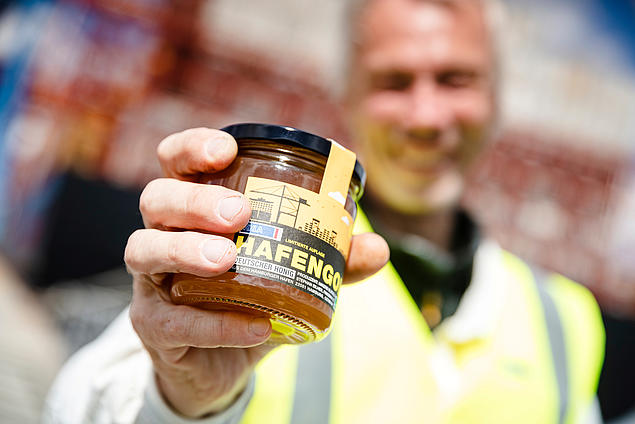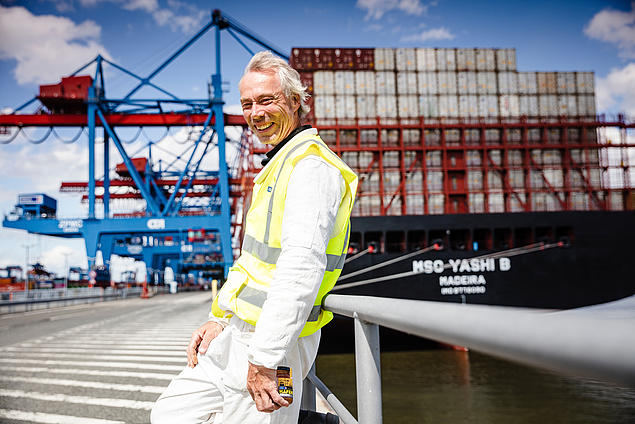Quicklinks
Quicklinks
The few visible employees at Container Terminal Altenwerder (CTA) are to be found in the glass pulpits of the 14 container gantry cranes. The outriggers of the gantry cranes move smoothly and evenly over the ship decks, pick up steel boxes and transport them to the quay edge. The further transport of the large metal boxes is fully automatic.
Things are much more hectic at the southern edge of the site, which covers more than a million square metres. The air is buzzing and there is a lot of activity around ten small wooden crates. Several thousand workers are active in this part of the port. They are small, naturally wear yellow and black protective waistcoats and can fly: they are bee colonies.
Their logistics task at the CTA looks a little different than handling containers. The bees collect nectar and honeydew in the vicinity of the plant. On an industrial site with ships, cranes, containers, trucks and the world's largest freight station, that's not an easy job, you would think.

"But that's deceptive," says beekeeper Stephan Iblher. "There are many fruit trees around the church in Altenwerder, and the Moorburger Elbdeich and some industrial wastelands in the vicinity offer a variety from lime to horse chestnut.
The 57-year-old is a beekeeper in his main profession and looks after 13 other sites in the Hamburg city area. At the CTA, his hard-working employees collected honey for 70 jars of harbour gold last year.
The inventor of the port honey - HHLA Sustainability Officer Jan Hendrik Pietsch - was less concerned with an original gift than with a healthy natural environment. Pietsch wanted above all to promote biodiversity in the Port of Hamburg. HHLA's Sustainability Officer therefore had the idea of providing a beekeeper with space for bees on the CTA. Pietsch searched via the HHLA staff newspaper and the article ended up at Iblher. That was five years ago now.
The beekeeper took the terminal's level of automation as an example. Using scales, solar cells and a telephone, he built a remote monitoring system for one of the ten beehives. "I get the weight of the box transmitted twice a day," says Iblher. An important value for the beekeeper, from which he can read how heavy the honey box is and when his presence is needed on site. Around 18 times a year, he comes to the CTA, slips his yellow high-visibility waistcoat over his protective beekeeping clothing and opens the boxes. If the bees do not find enough food outside the flowering season, he refills them with sugar water. He looks after the offspring and removes the combs for harvesting. Otherwise, he leaves the animals alone.
The bees are bio-filters.
With the direct proximity to emissions from ships and trucks, it is hard to believe that healthy food is being produced here. But Iblher waves it off: "The bees are bio-filters." The nectar is cleaned in the bee's honey bladder, residues end up in the wax of the combs. HHLA tests the honey for pollutants every year, and so far there have been no complaints. Pesticides are not an issue, as the plants grow wild and untreated in the surrounding area. The CTA is the world's first climate-neutral container terminal. Green electricity is used at all points where electrical energy is needed. Where fossil fuels are still burned, HHLA compensates by buying certificates for environmentally friendly projects, such as reforestation of the rainforest in Panama.

Iblher's great-grandfather was already a beekeeper. But this circle was to close only in the second attempt. The Hamburg native never wanted to go into agriculture. Stephan Iblher first completed a carpentry apprenticeship and built up an office furniture business with 15 employees. "At some point it became more and more difficult economically because customers no longer paid their bills on time," he says looking back. After the birth of his first of three children, he took a beekeeping course. It was supposed to be a hobby, a balance to his job. "But I enjoyed it so much that at some point I decided to change my career," says Iblher.
He has not regretted his decision to this day. The beekeeper enthusiastically recounts how he once observed a pheasant brooding next to a beehive. "I travel 30,000 km a year in the urban area and the activity in the fresh air keeps me fit," says Iblher. Most of the work on the product is done by his small staff, but setting up and mending the wooden boxes, pouring in the feed syrup and taking out the harvest twice a year at 14 locations is physical work.

Iblher does not want to reveal exactly where his other colonies are located, as he has already had problems with theft and vandalism in public spaces. Only this much: his colonies collect nectar around the wholesale market, at Jenischpark and at the Ohlsdorf cemetery. His goal is to expand to 300 colonies, which would mean up to 18 million bees. Only then will business pay off for his Elbgelb apiary.
There is only one thing Ilbher doesn't like about his job: the bee stings. "Many people think that as a beekeeper you eventually become immune to them. But can you become immune to pain?" he asks. His tally for this year, despite protective clothing: 82 stings. One imagines cooperative employees differently.
It is our aspiration to combine ecological, social and economic interests in order to make our company future-proof. We underline this with our "Balanced Logistics" sustainability strategy.
Read more